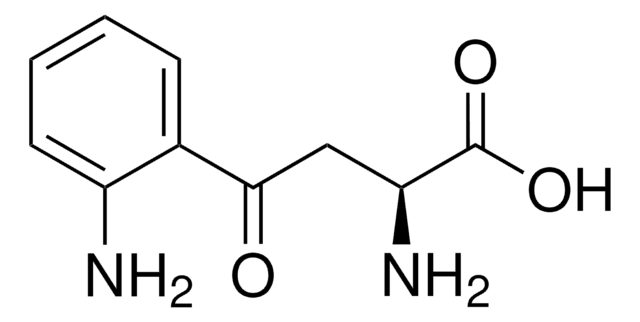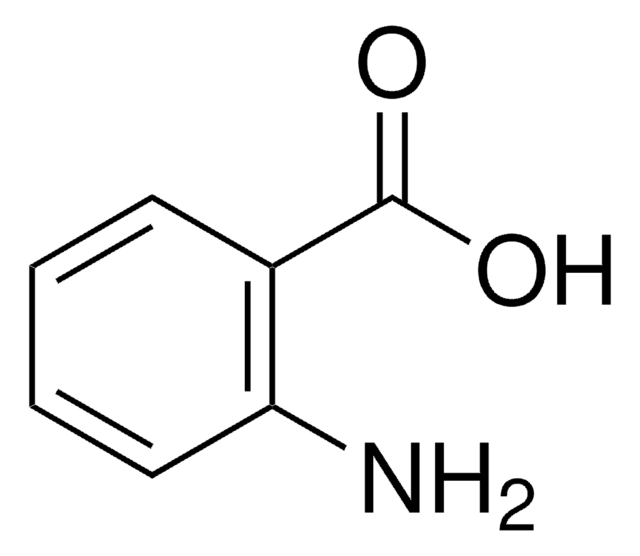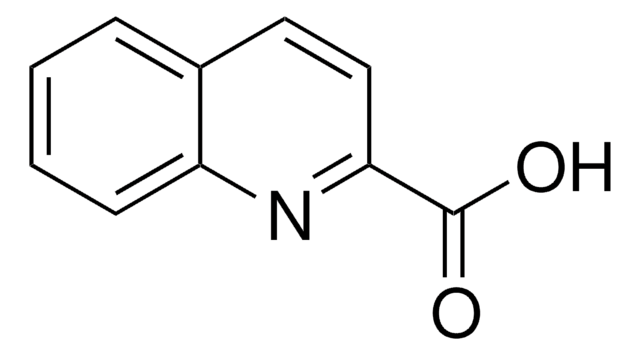H1771
3-Hydroxy-DL-Kynurenin
Synonym(e):
α,2-Diamino-3-hydroxy-γ-oxobenzolbutansäure
About This Item
Empfohlene Produkte
Assay
≥98% (TLC)
Qualitätsniveau
Form
powder
Löslichkeit
1 M HCl: 49.00-51.00 mg/mL, clear to very slightly hazy
Lagertemp.
2-8°C
SMILES String
NC(CC(=O)c1cccc(O)c1N)C(O)=O
InChI
1S/C10H12N2O4/c11-6(10(15)16)4-8(14)5-2-1-3-7(13)9(5)12/h1-3,6,13H,4,11-12H2,(H,15,16)
InChIKey
VCKPUUFAIGNJHC-UHFFFAOYSA-N
Suchen Sie nach ähnlichen Produkten? Aufrufen Leitfaden zum Produktvergleich
Allgemeine Beschreibung
Anwendung
- als Substrat für den rekombinanten humanen Kynureninase-Assay
- als Referenzstandard für die Tandem-Massenspektrometrie-Analyse (MS/MS)
- als Kontrolle zum Quantifizieren der Serumwerte von 3-Hydroxy-DL-kynurenin bei Patienten mit diabetischer Retinopathie
Biochem./physiol. Wirkung
Signalwort
Warning
H-Sätze
Gefahreneinstufungen
Eye Irrit. 2 - Skin Irrit. 2 - STOT SE 3
Zielorgane
Respiratory system
Lagerklassenschlüssel
11 - Combustible Solids
WGK
WGK 3
Flammpunkt (°F)
Not applicable
Flammpunkt (°C)
Not applicable
Persönliche Schutzausrüstung
dust mask type N95 (US), Eyeshields, Gloves
Analysenzertifikate (COA)
Suchen Sie nach Analysenzertifikate (COA), indem Sie die Lot-/Chargennummer des Produkts eingeben. Lot- und Chargennummern sind auf dem Produktetikett hinter den Wörtern ‘Lot’ oder ‘Batch’ (Lot oder Charge) zu finden.
Besitzen Sie dieses Produkt bereits?
In der Dokumentenbibliothek finden Sie die Dokumentation zu den Produkten, die Sie kürzlich erworben haben.
Kunden haben sich ebenfalls angesehen
Unser Team von Wissenschaftlern verfügt über Erfahrung in allen Forschungsbereichen einschließlich Life Science, Materialwissenschaften, chemischer Synthese, Chromatographie, Analytik und vielen mehr..
Setzen Sie sich mit dem technischen Dienst in Verbindung.











